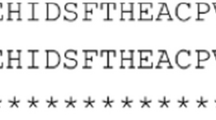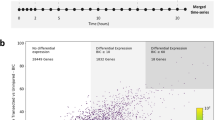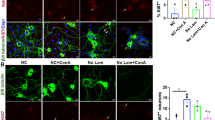Abstract
Sortilin1 (∼95 kDa) is a member of the recently discovered family of Vps10p-domain receptors2,3, and is expressed in a variety of tissues, notably brain, spinal cord and muscle. It acts as a receptor for neurotensin4,5, but predominates in regions of the nervous system that neither synthesize nor respond to this neuropeptide6, suggesting that sortilin has additional roles. Sortilin is expressed during embryogenesis7 in areas where nerve growth factor (NGF) and its precursor, proNGF, have well-characterized effects6,7. These neurotrophins can be released by neuronal tissues8,9, and they regulate neuronal development through cell survival and cell death signalling. NGF regulates cell survival and cell death via binding to two different receptors, TrkA and p75NTR (ref. 10). In contrast, proNGF selectively induces apoptosis through p75NTR but not TrkA11. However, not all p75NTR-expressing cells respond to proNGF, suggesting that additional membrane proteins are required for the induction of cell death. Here we report that proNGF creates a signalling complex by simultaneously binding to p75NTR and sortilin. Thus sortilin acts as a co-receptor and molecular switch governing the p75NTR-mediated pro-apoptotic signal induced by proNGF.
This is a preview of subscription content, access via your institution
Access options
Subscribe to this journal
Receive 51 print issues and online access
$199.00 per year
only $3.90 per issue
Buy this article
- Purchase on Springer Link
- Instant access to full article PDF
Prices may be subject to local taxes which are calculated during checkout




Similar content being viewed by others
References
Petersen, C. M. et al. Molecular identification of a novel candidate sorting receptor purified from human brain by receptor-associated protein affinity chromatography. J. Biol. Chem. 272, 3599–3605 (1997)
Hermey, G. et al. Characterization of sorCS1, an alternatively spliced receptor with completely different cytoplasmic domains that mediate different trafficking in cells. J. Biol. Chem. 278, 7390–7396 (2003)
Jacobsen, L. et al. Activation and functional characterization of the mosaic receptor SorLA/LR11. J. Biol. Chem. 276, 22788–22796 (2001)
Mazella, J. et al. The 100-kDa neurotensin receptor is gp95/sortilin, a non-G-protein-coupled receptor. J. Biol. Chem. 273, 26273–26276 (1998)
Munck, P. C. et al. Propeptide cleavage conditions sortilin/neurotensin receptor-3 for ligand binding. EMBO J. 18, 595–604 (1999)
Sarret, P. et al. Distribution of NTS3 receptor/sortilin mRNA and protein in the rat central nervous system. J. Comp. Neurol. 461, 483–505 (2003)
Hermans-Borgmeyer, I., Hermey, G., Nykjaer, A. & Schaller, C. Expression of the 100-kDa neurotensin receptor sortilin during mouse embryonal development. Brain Res. Mol. Brain Res. 65, 216–219 (1999)
Beattie, M. S. et al. ProNGF induces p75-mediated death of oligodendrocytes following spinal cord injury. Neuron 36, 375–386 (2002)
Hasan, W., Pedchenko, T., Krizsan-Agbas, D., Baum, L. & Smith, P. G. Sympathetic neurons synthesize and secrete pro-nerve growth factor protein. J. Neurobiol. 57, 38–53 (2003)
Chao, M. V. Neurotrophins and their receptors: a convergence point for many signalling pathways. Nature Rev. Neurosci. 4, 299–309 (2003)
Lee, R., Kermani, P., Teng, K. K. & Hempstead, B. L. Regulation of cell survival by secreted proneurotrophins. Science 294, 1945–1948 (2001)
Esposito, D. et al. The cytoplasmic and transmembrane domains of the p75 and Trk A receptors regulate high affinity binding to nerve growth factor. J. Biol. Chem. 276, 32687–32695 (2001)
Mahadeo, D., Kaplan, L., Chao, M. V. & Hempstead, B. L. High affinity nerve growth factor binding displays a faster rate of association than p140trk binding. Implications for multi-subunit polypeptide receptors. J. Biol. Chem. 269, 6884–6891 (1994)
Fahnestock, M., Michalski, B., Xu, B. & Coughlin, M. D. The precursor pro-nerve growth factor is the predominant form of nerve growth factor in brain and is increased in Alzheimer's disease. Mol. Cell. Neurosci. 18, 210–220 (2001)
Heymach, J. V. Jr & Shooter, E. M. The biosynthesis of neurotrophin heterodimers by transfected mammalian cells. J. Biol. Chem. 270, 12297–12304 (1995)
Nielsen, M. S. et al. The sortilin cytoplasmic tail conveys Golgi-endosome transport and binds the VHS domain of the GGA2 sorting protein. EMBO J. 20, 2180–2190 (2001)
Gargano, N., Levi, A. & Alema, S. Modulation of nerve growth factor internalization by direct interaction between p75 and TrkA receptors. J. Neurosci. Res. 50, 1–12 (1997)
Bronfman, F. C., Tcherpakov, M., Jovin, T. M. & Fainzilber, M. Ligand-induced internalization of the p75 neurotrophin receptor: a slow route to the signaling endosome. J. Neurosci. 23, 3209–3220 (2003)
Shonukan, O., Bagayogo, I., McCrea, P., Chao, M. & Hempstead, B. Neurotrophin-induced melanoma cell migration is mediated through the actin-bundling protein fascin. Oncogene 22, 3616–3623 (2003)
Lee, K. F. et al. Targeted mutation of the gene encoding the low affinity NGF receptor p75 leads to deficits in the peripheral sensory nervous system. Cell 69, 737–749 (1992)
Rattenholl, A. et al. The pro-sequence facilitates folding of human nerve growth factor from Escherichia coli inclusion bodies. Eur. J. Biochem. 268, 3296–3303 (2001)
Hempstead, B. L., Schleifer, L. S. & Chao, M. V. Expression of functional nerve growth factor receptors after gene transfer. Science 243, 373–375 (1989)
Hempstead, B. L., Martin-Zanca, D., Kaplan, D. R., Parada, L. F. & Chao, M. V. High-affinity NGF binding requires coexpression of the trk proto-oncogene and the low-affinity NGF receptor. Nature 350, 678–683 (1991)
Nykjaer, A. et al. Cubilin dysfunction causes abnormal metabolism of the steroid hormone 25(OH) vitamin D(3). Proc. Natl Acad. Sci. USA 98, 13895–13900 (2001)
Einheber, S., Milner, T. A., Giancotti, F. & Salzer, J. L. Axonal regulation of Schwann cell integrin expression suggests a role for α6 β4 in myelination. J. Cell Biol. 123, 1223–1236 (1993)
Nykjaer, A. et al. Mannose 6-phosphate/insulin-like growth factor-II receptor targets the urokinase receptor to lysosomes via a novel binding interaction. J. Cell Biol. 141, 815–828 (1998)
Wang, S. et al. p75(NTR) mediates neurotrophin-induced apoptosis of vascular smooth muscle cells. Am. J. Pathol. 157, 1247–1258 (2000)
Mitsui, C., Sakai, K., Ninomiya, T. & Koike, T. Involvement of TLCK-sensitive serine protease in colchicine-induced cell death of sympathetic neurons in culture. J. Neurosci. Res. 66, 601–611 (2001)
Bamji, S. X. et al. The p75 neurotrophin receptor mediates neuronal apoptosis and is essential for naturally occurring sympathetic neuron death. J. Cell Biol. 140, 911–923 (1998)
Acknowledgements
We thank M. V. Chao and G. R. Lewin for valuable discussions. J. Salzer, R. Kraemer and P. Fischer are acknowledged for reagents and advice, and S. Tevar for assistance in p75NTR mice genotyping. This work was supported by the Novo Nordisk Foundation, The Danish Medical Research Council, The Carlsberg Foundation (A.N. and C.M.P.) and the NIH (B.L.H. and R.L.).
Author information
Authors and Affiliations
Corresponding author
Ethics declarations
Competing interests
The authors declare that they have no competing financial interests.
Rights and permissions
About this article
Cite this article
Nykjaer, A., Lee, R., Teng, K. et al. Sortilin is essential for proNGF-induced neuronal cell death. Nature 427, 843–848 (2004). https://doi.org/10.1038/nature02319
Received:
Accepted:
Issue Date:
DOI: https://doi.org/10.1038/nature02319
This article is cited by
-
Analysis of β-nerve growth factor and its precursor during human pregnancy by immunoaffinity-liquid chromatography tandem mass spectrometry
Scientific Reports (2023)
-
Surfeit Locus Protein 4 as a Novel Target for Therapeutic Intervention in Cerebral Ischemia–Reperfusion Injury
Molecular Neurobiology (2023)
-
The emerging role of furin in neurodegenerative and neuropsychiatric diseases
Translational Neurodegeneration (2022)
-
Finding memo: versatile interactions of the VPS10p-Domain receptors in Alzheimer’s disease
Molecular Neurodegeneration (2022)
-
SorCS3 promotes the internalization of p75NTR to inhibit GBM progression
Cell Death & Disease (2022)
Comments
By submitting a comment you agree to abide by our Terms and Community Guidelines. If you find something abusive or that does not comply with our terms or guidelines please flag it as inappropriate.



